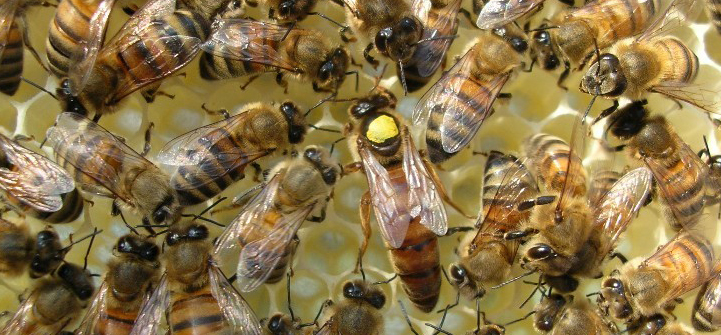It is assumed that raw honey is neither heated nor filtered. As there is no official or legal definition of raw honey, it is possible that a product labeled raw honey may have been heated or filtered. – Nancy Ostiguy, Pennsylvania State University…
If honey becomes crystallized (solid) has it gone ‘bad’?
Honey does not spoil. Crystallized honey is caused by the glucose in liquid honey becoming a solid. Honey can be consumed in its crystallized form or you can warm the honey to dissolve the crystals by placing the jar in warm water and stirring until the crystals disappear. Do not boil or scorch the honey. – Nancy Ostiguy, Pennsylvania State University…
What is Nosema disease?
Nosema disease in honey bees is caused by two species of pathogens, Nosema apis and Nosema ceranae. Nosema apis was the only known microsporidian honey bee pathogen until 1996, when a second species, Nosema ceranae, was identified from the Asian honey bee. Nosema ceranae appears to be the dominant species in the European honey bee (Apis mellifera) in many parts of the world, including in Europe and the United States. Both of these pathogens cause chronic deleterious effects in the …
How is Nosema disease treated?
Nosema disease can be treated successfully with Fumigillin (trade name Fumidil). Colonies are usually treated in the fall, spring, or both. Follow the directions on the label and feed the correct dosage in 50% sugar syrup (1:1 sugar:water, with antibiotic dissolved in 5-10 ml warm water then mixed into the syrup) in the spring, 66% in the fall. Nosema ceranae also responds to Fumidil treatment, but may require a higher dosage. The antibiotic does not kill the spores, but disrupts …
High Levels of Miticides and Agrochemicals in North American Apiaries: Implications for Honey Bee Health
Citation: Mullin CA, Frazier M, Frazier JL, Ashcraft S, Simonds R, et al. 2010 High Levels of Miticides and Agrochemicals in North American Apiaries: Implications for Honey Bee Health. PLoS ONE 5(3): e9754. doi:10.1371/journal.pone.0009754
Web Link:www.plosone.org
Brief Description:
Recent declines in honey bees for crop pollination threaten fruit, nut, vegetable and seed production in the United States. A broad survey of pesticide residues was conducted on samples from migratory and other beekeepers across 23 states, one Canadian province and …
How do honey bees make wax?
Bees produce the beeswax used in the construction of their combs from the four pair of wax glands located on the underside of the abdomen. These glands are most highly developed and active in bees 10-18 days old. The wax appears in small, irregular oval flakes or scales that project between the overlapped portions of the last four abdominal segments. Wax can be secreted only at relatively high temperatures and after a large intake of honey or nectar. -John Skinner, …
What are wax moths and what kind of damage do they make in a beehive?
There are two species of wax moth that cause damage to honey bee colonies by consuming beeswax as their larvae develop and in the process of making a pupal cocoon they score the wooden frames that hold the wax combs, weakening the wood. Damage becomes obvious as they produce large quantities of gray-white webbing and dark fecal material as they feed. The larger of the two species (3/4 inch long gray-brown adult), the greater wax moth, Gallaria melonella causes more …
What are some ways to reduce the population of Varroa mites in honey bee colonies, without the use of pesticides?
Mite-resistant Bees. In response to development of resistance to chemical miticides, and in order to provide more sustainable mite management, honey bees have been selectively bred for resistance to, or tolerance of, Varroa. There are two known mechanisms of resistance: hygienic behavior and suppression of mite reproduction (SMR). Hygiene is the removal of diseased (including mite-parasitized) brood by workers; SMR is the reduction in reproduction of female mites within brood cells. Types of resistant queens include; Minnesota Hygienic, the Russian …
How can honey bees produce honey from nectar that is toxic to them?
Some plants produce nectar that is poisonous to bees. It is difficult to understand how honey bees can produce honey from this toxic nectar. The effect on the bee is probably dose related at an individual as well as a colony level. The bee must consume a minimum amount of the toxin before it is affected. If the bee is visiting other non-toxic plants before returning to the colony, the toxin from the poisonous nectar may be diluted. Another factor …
How do I know whether my bees have Nosema disease?
The only way to be sure is to examine bees by microscope. A sample of bees is macerated in a small amount of water, and then a drop of the liquid is examined on a microscope slide at 400 power. Spores appear as ovals, about 3 by 5 microns. One outward indication of Nosema is brown spots (fecal material) on the outside or inside of a hive. The inner cover or top bars can be soiled with feces in a …
